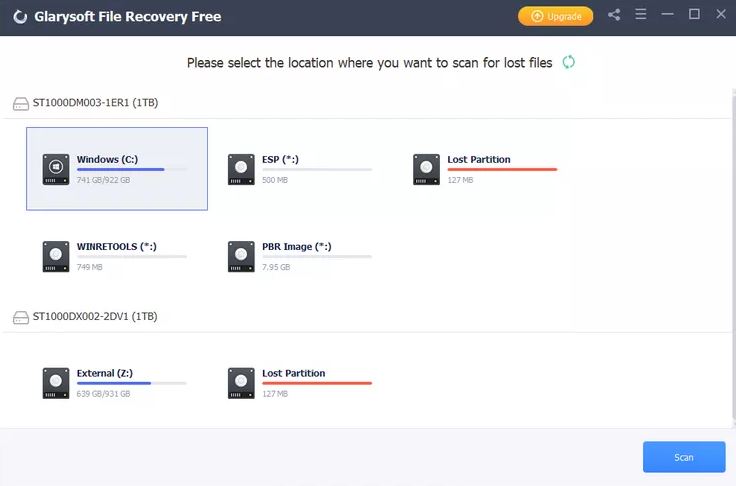Best Free Data Recovery Software Tools of 2024

A variety of impressive free Data Recovery Software Tools emerged, each equipped with distinct features and capabilities. Whether your goal is to recover deleted files, retrieve lost partitions, or access inaccessible data, the top free data recovery software options have covered you.
These tools, such as Recuva, Wise Data Recovery, Windows File Recovery, EaseUS Data Recovery Wizard, Stellar Data Recovery, Disk Drill, and EaseUS Data Recovery Wizard, offer highly customizable searches and deep scan abilities.

They simplify the retrieval of a diverse range of items from different storage devices, emphasizing user-friendly interfaces and robust performance to provide essential solutions for reliable data recovery.
Recuva
Recuva stands out as the ultimate free data recovery software tool available today, without a doubt. Its user-friendly interface makes it incredibly easy to navigate, yet it also offers a plethora of optional advanced features. Whenever someone asks for a recommendation for such a tool, Recuva is always my top choice.
It boasts the capability to retrieve files from various sources including hard drives, external drives (such as USB drives), BD/DVD/CDs, and memory cards. Remarkably, it can even restore deleted files from your iPod!

The process of recovering a deleted file is as simple as deleting one. For anyone in need of file recovery assistance, I strongly suggest trying Recuva as your first option.
This free application from Piriform is compatible with Windows 11, 10, 8 & 8.1, 7, Vista, and XP. I conducted file recovery tests using version 1.53 on Windows 11, and it performed admirably.
- Abundance of advanced options
- User-friendly wizard walkthrough simplifies usage
- Compatible with the majority of Windows operating systems
- Updates are infrequent
Wise Data Recovery
Wise Data Recovery offers a straightforward approach to undeleting files, making it a hassle-free program to utilize. Its quick installation process and swift PC scanning capabilities were particularly impressive to me. Additionally, it efficiently checks for deleted files across various USB devices like memory cards and other removable media.
The inclusion of an instant search function enhances user experience by swiftly locating deleted files identified by the program. Moreover, it provides both quick and full scan options, catering to different needs for thoroughness in file recovery.

While some programs offer insights into the recoverability of a file before attempting to undelete it, Wise Data Recovery lacks this feature, which may disappoint some users.
Additionally, it imposes a limitation on data recovery, allowing undeletion of up to 2 GB of data only.
Wise Data Recovery is compatible with Windows 11, 10, 8, 7, Vista, and XP, as well as macOS. For added convenience, a portable version of the software is available for download via Softpedia.
- Endorsed by Microsoft
- Supports both internal and external drives, including SD cards
- Offers extensive options for customization
- Requires Windows 11 or 10 operating system
- Operates through the command line interface
- Necessitates restoration to a different drive
Windows File Recovery
Even though Microsoft provides a tool for data recovery, it’s not as user-friendly as most other programs. This tool operates through the command line interface, meaning users have to manually type out commands for each action. However, it’s still relatively straightforward to use.
To undelete files using this method, you’ll need to download and install Windows File Recovery. Once installed, you can find it in the Start menu and open it. From there, you can input commands to perform tasks, such as recovering PNG images from the Downloads folder on your C drive and copying them to the Images folder on a drive labelled E.

Since this process is more involved than using a standard application with buttons and menus, I recommend referring to Microsoft’s help page for additional examples and detailed instructions. This resource guides various aspects of file recovery, including recovering single files or multiple file types at once, using wildcards, and more.
- Endorsed by Microsoft, ensuring reliability and compatibility with Windows systems
- Supports recovery from a variety of storage devices, including internal and external drives, USB devices, memory cards, and more
- Provides multiple scan options for flexibility in data recovery
- Offers the ability to recover specific file types or multiple file types simultaneously
- Can recover files from deleted partitions if not overwritten
- Operates through the command line interface, which may be less intuitive for some users
- Limited user-friendly features compared to graphical user interface-based recovery tools
- Requires manual input of commands for each action, potentially increasing the likelihood of errors
EaseUS Data Recovery Wizard
EaseUS Data Recovery Wizard stands out as another excellent file undelete program, offering a seamless file recovery process with just a few clicks.
One standout feature of this program is its user interface, which closely resembles File Explorer. While this interface may not suit everyone’s preferences, it provides a familiar environment that most users find comfortable to navigate.

EaseUS Data Recovery Wizard can retrieve files from a wide range of storage devices, including hard drives, optical drives, memory cards, iOS devices, cameras, and more. Additionally, it supports partition recovery.
It’s important to note that the program has a data recovery limit of 512 MB, which can be extended to 2 GB by sharing about the software on social media. While this limitation may seem restrictive, it’s often sufficient for most file recovery needs. However, for larger files or more frequent use, users may need to consider upgrading.
Despite this limitation, EaseUS Data Recovery Wizard remains a valuable tool, especially considering its compatibility with macOS versions 12 through 10.9, Windows 11, 10, 8, and 7, as well as various Windows Server editions. Additionally, with nearly two dozen other options available in the market, users have plenty of alternatives to choose from for their data recovery needs.
- Enables backup of scan results for later file restoration without requiring a full drive rescan
- Compatible with both Windows and macOS operating systems
- Facilitates file sorting by type, deletion date, and name
- Allows browsing of folders similar to File Explorer
- Supports file previewing before restoration
- Limited to recovering only 2 GB of data
- No portable version is available
Puran File Recovery
Puran File Recovery emerges as one of the top contenders in the realm of data recovery solutions. Despite its outdated interface, its functionality remains unaffected and highly efficient. With a user-friendly design, it seamlessly scans any drive recognized by Windows and offers a plethora of advanced options for those requiring more customization.
Notably, Puran File Recovery stands out for its ability to identify a higher number of files compared to many other tools during testing. Therefore, it’s worth considering alongside Recuva if your desired files aren’t found initially.

Moreover, this tool excels in recovering lost partitions, provided they haven’t been overwritten.
Compatible with Windows 10, 8, 7, Vista, and XP, Puran File Recovery is also available in a portable format for both 32-bit and 64-bit Windows versions, eliminating the need for installation and enhancing its accessibility.
- Offers two viewing options for the list of deleted files
- Supports running as a portable version for added convenience
- Capable of scanning NTFS and FAT12/16/32 file systems
- Provides a clear indication of file recoverability
- Free for home use only, not suitable for commercial or business purposes
- Hasn’t received updates since 2016
Glarysoft File Recovery Free
Glarysoft File Recovery Free stands out as a straightforward and user-friendly program for file recovery. While it may not offer an extensive range of options compared to higher-ranked choices, it remains effective and easy to navigate.
Simply select a drive, initiate the scan for deleted files, and proceed to choose the ones you wish to recover. An advantageous feature is the ability to undelete items while the scan is ongoing, minimizing wait times. Additionally, the option to pause the scan is available.

Users can refine their search using filters based on file type, deletion time, size, and keywords. Furthermore, there’s a customizable setting allowing users to designate specific file extensions to corresponding categories, such as categorizing MP4s as videos. Users can also add their extensions as needed.
However, it’s worth noting that the free version of the app imposes a 2 GB limit on file recovery, which may restrict users with extensive recovery needs. Nevertheless, this should suffice for most users, particularly those who infrequently utilize such tools or deal with small files.
Glarysoft File Recovery Free is compatible with FAT, NTFS, and EFS file systems, ensuring broad compatibility. Version 1 of the software was tested on Windows 10.
- User-friendly interface for viewing the list of deleted files
- Allows recovery to any desired folder location
- Free recovery is limited to 2 GB
- Setup process may attempt to install additional unwanted programs
- Lacks display of file recoverability odds
- Not portable; requires installation
Disk Drill
Disk Drill stands out as an exceptional free data recovery program, not only for its robust features but also for its user-friendly design, ensuring minimal confusion during use.
According to their website, Disk Drill boasts the capability to recover data from “virtually any storage device,” encompassing internal and external hard drives, USB devices, memory cards, and iPods.
It offers numerous valuable features, including the ability to preview files before recovery, pause and resume scans, perform partition recovery, back up entire drives, filter files by date or size, choose between quick and full scans for faster results, and save scan results for easy retrieval of deleted files at a later time.

However, a significant drawback is the 500 MB recovery limit, which may prove restrictive, particularly for users with extensive data recovery needs.
The latest version of Disk Drill is compatible with 64-bit editions of Windows 11 and Windows 10, as well as macOS 10.15 and newer. Earlier versions are also available for older operating systems such as Windows 8 through XP.
- Organizes deleted files by category, enhancing ease of viewing
- Allows filtering of results by size and/or date
- Supports both quick scan and deep scan modes for thorough recovery
- Compatible with several different file systems
- Limits data recovery to 500 MB
- Requires installation; no portable version available
iCare Data Recovery Free
iCare Data Recovery Free offers users the choice between two scan options: a quicker scan type, which may not capture everything but provides faster results, and a deeper scan that takes longer but is more likely to locate additional deleted files.
One standout feature of this program, which I find particularly useful and wish was included in all file recovery tools, is the ability to preview text and image files. Additionally, users can browse deleted folders in thumbnail view, facilitating quick identification of desired files for recovery.

With support for several hundred file types, iCare Data Recovery Free is capable of recovering a wide range of deleted files.
Windows users have the option to download this program as either a portable tool or a normal, installable program. It is compatible with Windows 11, 10, 8, and 7 operating systems.
- Availability of a portable version
- Ability to preview files before recovery
- Option to search through the results list
- Support for a wide range of file types
- The interface may feel outdated
- Inability to pause a scan and resume it later
FAQs About Best Free Data Recovery Software Tools
There’s no single “best” option, as different tools excel in different areas. Some popular free options include Recuva, Disk Drill, Wise Data Recovery, and TestDisk/PhotoRec. Consider factors like ease of use, file types supported, and specific recovery needs when choosing.
Most tools support common file types like documents, photos, videos, and music. Some offer broader recovery, including emails, system files, and even raw data. Check the tool’s specifications for details.
Yes, free tools can be surprisingly effective! It depends on the situation – recently deleted files on healthy drives have a higher recovery chance. Remember, success isn’t guaranteed, but trying a free tool before paying is often wise.
Generally, yes. Reputable tools like those mentioned earlier should be safe. However, exercise caution – avoid downloading from untrusted sources or clicking suspicious ads.
Stop using the device where the data loss occurred to prevent overwriting. If possible, connect the storage device directly to your computer instead of using external adapters
Free tools often have limitations compared to paid versions. These might include file size restrictions, limited recovery features, or slower scan speeds.






